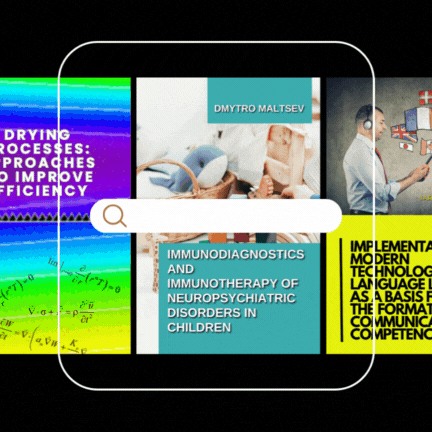Creating a microclimatic thermal mode by the multilevel system for heating industrial structures
DOI:
https://doi.org/10.15587/1729-4061.2020.196763Keywords:
forming the predefined microclimate mode, electrothermal processes, thermal conductivity, heating floor, tubular heatersAbstract
A heating system for predicting the thermal state, to control and regulate the heating of technologically active zones of production facilities has been proposed. This makes it possible to ensure a high-quality level of compliance with the standards of the thermal mode at production facilities through the use of energy-saving multifunctional systems of a multi-level heating system. At the same time, the heating devices of the resistor type are located below the floor level and their heaters are powered by traditional and non-traditional renewable energy sources.
Modeling of thermal processes in the heating system, which was reduced to solving the problem of heat conductivity in the flat layer system, was carried out. A constituent part of this solution is to determine the floor surface temperature as a functional series, which establishes a relationship between the standards of floor surface heating and the power of energy flows in a multilevel heating system. This approach makes it possible to ensure the structural and functional control of energy flows and at the same time ensure the responsiveness and accuracy of compliance with the set standards of the thermal parameters of the microclimate of the technologically active area of industrial facilities for various functional purposesReferences
- Romanchenko, N. (2017). Analytical investigations of the distribution of the temperature field in the multilayer structure of electric-heating floor. Visnyk Kharkivskoho natsionalnoho tekhnichnoho universytetu silskoho hospodarstva imeni Petra Vasylenka, 187, 84–87.
- Banhazi, T. M., Seedorf, J., Laffrique, M., Rutley, D. L. (2008). Identification of the risk factors for high airborne particle concentrations in broiler buildings using statistical modelling. Biosystems Engineering, 101 (1), 100–110. doi: https://doi.org/10.1016/j.biosystemseng.2008.06.007
- Kuznik, F., Virgone, J. (2009). Experimental assessment of a phase change material for wall building use. Applied Energy, 86 (10), 2038–2046. doi: https://doi.org/10.1016/j.apenergy.2009.01.004
- Vučemilo, M., Matković, K., Vinković, B., Macan, J., Varnai, V. M., Prester, L. et. al. (2008). Effect of microclimate on the airborne dust and endotoxin concentration in a broiler house. Czech Journal of Animal Science, 53 (2), 83–89. doi: https://doi.org/10.17221/329-cjas
- Romanchenko, M., Slesarenko, A., Kundenko, M. (2018). Effect of thermal field distribution in the layered structure of a heating floor on the temperature of its surface. Eastern-European Journal of Enterprise Technologies, 1 (8 (91)), 57–63. doi: https://doi.org/10.15587/1729-4061.2018.121827
- Sharma, A., Tyagi, V. V., Chen, C. R., Buddhi, D. (2009). Review on thermal energy storage with phase change materials and applications. Renewable and Sustainable Energy Reviews, 13 (2), 318–345. doi: https://doi.org/10.1016/j.rser.2007.10.005
- Yao, H. Q., Choi, H. L., Lee, J. H., Suresh, A., Zhu, K. (2010). Effect of microclimate on particulate matter, airborne bacteria, and odorous compounds in swine nursery houses. Journal of Animal Science, 88 (11), 3707–3714. doi: https://doi.org/10.2527/jas.2009-2399
- Krommweh, M. S., Rösmann, P., Büscher, W. (2014). Investigation of heating and cooling potential of a modular housing system for fattening pigs with integrated geothermal heat exchanger. Biosystems Engineering, 121, 118–129. doi: https://doi.org/10.1016/j.biosystemseng.2014.02.008
- Li, H., Rong, L., Zhang, G. (2016). Study on convective heat transfer from pig models by CFD in a virtual wind tunnel. Computers and Electronics in Agriculture, 123, 203–210. doi: https://doi.org/10.1016/j.compag.2016.02.027
- Rojano, F., Bournet, P.-E., Hassouna, M., Robin, P., Kacira, M., Choi, C. Y. (2015). Modelling heat and mass transfer of a broiler house using computational fluid dynamics. Biosystems Engineering, 136, 25–38. doi: https://doi.org/10.1016/j.biosystemseng.2015.05.004
- Seo, I., Lee, I., Moon, O., Hong, S., Hwang, H., Bitog, J. P. et. al. (2012). Modelling of internal environmental conditions in a full-scale commercial pig house containing animals. Biosystems Engineering, 111 (1), 91–106. doi: https://doi.org/10.1016/j.biosystemseng.2011.10.012
- Maliarenko, V. A. (2009). Osnovy teplofizyky budivel ta enerhozberezhennia. Kharkiv: «Vydavnytstvo SAHA», 484.
- Yaremko, Z. M., Tymoshuk, S. V., Tretiak, O. I., Kovtun, R. M. (2010). Okhorona pratsi. Lviv: Vydavnychyi tsentr LNU imeni Ivana Franka, 374.
Downloads
Published
How to Cite
Issue
Section
License
Copyright (c) 2020 Nikolai Romanchenko, Vladimir Romanchenko, Nikolai Kundenko, Yuri Sanin

This work is licensed under a Creative Commons Attribution 4.0 International License.
The consolidation and conditions for the transfer of copyright (identification of authorship) is carried out in the License Agreement. In particular, the authors reserve the right to the authorship of their manuscript and transfer the first publication of this work to the journal under the terms of the Creative Commons CC BY license. At the same time, they have the right to conclude on their own additional agreements concerning the non-exclusive distribution of the work in the form in which it was published by this journal, but provided that the link to the first publication of the article in this journal is preserved.
A license agreement is a document in which the author warrants that he/she owns all copyright for the work (manuscript, article, etc.).
The authors, signing the License Agreement with TECHNOLOGY CENTER PC, have all rights to the further use of their work, provided that they link to our edition in which the work was published.
According to the terms of the License Agreement, the Publisher TECHNOLOGY CENTER PC does not take away your copyrights and receives permission from the authors to use and dissemination of the publication through the world's scientific resources (own electronic resources, scientometric databases, repositories, libraries, etc.).
In the absence of a signed License Agreement or in the absence of this agreement of identifiers allowing to identify the identity of the author, the editors have no right to work with the manuscript.
It is important to remember that there is another type of agreement between authors and publishers – when copyright is transferred from the authors to the publisher. In this case, the authors lose ownership of their work and may not use it in any way.









